Thursday, August 24, 2006
A journey to the abode of the clouds
 There is an air of expectancy in the journey. You begin your trip and soon hit the hills as the road follows a serpentine path, giving you the first impression of a peculiar quaintness. The small road side tea shops, the glistening pots and pans scubbed to a silvery sheen, the smiling khasi ladies serving at the tea stalls, an innovative water supply system of bamboos dug out to serve as pipes,all giving a feeling of neatness, a feeling of living with nature.
There is an air of expectancy in the journey. You begin your trip and soon hit the hills as the road follows a serpentine path, giving you the first impression of a peculiar quaintness. The small road side tea shops, the glistening pots and pans scubbed to a silvery sheen, the smiling khasi ladies serving at the tea stalls, an innovative water supply system of bamboos dug out to serve as pipes,all giving a feeling of neatness, a feeling of living with nature.The road winds its way through tropical forests and with each bend of the road you get a glimpse of the variety of the flora and fauna that abound the state of Meghalaya often likened to Scotland for its topography, scenic beauty and vegetation,it presents a panorama of lush, rolling hills; heather-covered slopes; breathtakingly beautiful waterfalls; mountain springs; moving mists; silent lakes, and multitude of flora and fauna, including rare and unique species.A flock of parrots may whoosh past your car, a lone orchid would hang in silent resplendence on a giant tree, the turtle doves would scamper to safety to give way to your car and the most charming and exhilarating part of it a drive through the rain with the sun still shining and then your car suddenly disappearing into the mist to transport you to another heavenly experience.
 After a short journey from Guwahati one reaches Byrnihat, a famous trading place since yore and now a bustling township. One can take a detour and visit the picnic spot of Umtru. Most of the villages on the way have a name beginning with 'um' meaning water in the Khasi language. The road winds ahead and an interesting part of the journey is the stretch beyond Umling where one can reach uphill and look down to see the road traversed to reach the high point. All through the journey babbling streams run along the road and you are served with chilled mineral water at any point. For the more enterprising traveller there are many rapids river flowing along, touching the road at several points gives him the chances to take a quick dip or to guzzle a frothy beer.
After a short journey from Guwahati one reaches Byrnihat, a famous trading place since yore and now a bustling township. One can take a detour and visit the picnic spot of Umtru. Most of the villages on the way have a name beginning with 'um' meaning water in the Khasi language. The road winds ahead and an interesting part of the journey is the stretch beyond Umling where one can reach uphill and look down to see the road traversed to reach the high point. All through the journey babbling streams run along the road and you are served with chilled mineral water at any point. For the more enterprising traveller there are many rapids river flowing along, touching the road at several points gives him the chances to take a quick dip or to guzzle a frothy beer. Nongpoh is the mid-point of the journey. In the good old days when a backpack ride or ponies were the only means of reaching Shillong, this was the overnight rest spot. From here it was 60 km of the journey past and 60 km of the journey ahead. The road side market of Nongpoh has a flavour of its own. The fruit stalls are a major draw, with luscious fruit at throw away prices. For the everyday traveller there is a variety of vegetables, both from the plains and the hills. The Nongpoh market was once famous for its venision, parrots and mynas pet stalls, but for them to be available today one needs a fair share of luck also, you can buy orchids at unbelievably low prices, if you are lucky. A captivating up-hill drive through idyllic country scenario and you enter 'pineland'. As the winds whisper through them, the sonorous chirping of the birds is broken by the roar of water hurtling down and believe it, you can feel the spray, sitting down in your car a waterfall cascading down in silver and froth, to lap up the boulders and rocks below.
Nongpoh is the mid-point of the journey. In the good old days when a backpack ride or ponies were the only means of reaching Shillong, this was the overnight rest spot. From here it was 60 km of the journey past and 60 km of the journey ahead. The road side market of Nongpoh has a flavour of its own. The fruit stalls are a major draw, with luscious fruit at throw away prices. For the everyday traveller there is a variety of vegetables, both from the plains and the hills. The Nongpoh market was once famous for its venision, parrots and mynas pet stalls, but for them to be available today one needs a fair share of luck also, you can buy orchids at unbelievably low prices, if you are lucky. A captivating up-hill drive through idyllic country scenario and you enter 'pineland'. As the winds whisper through them, the sonorous chirping of the birds is broken by the roar of water hurtling down and believe it, you can feel the spray, sitting down in your car a waterfall cascading down in silver and froth, to lap up the boulders and rocks below.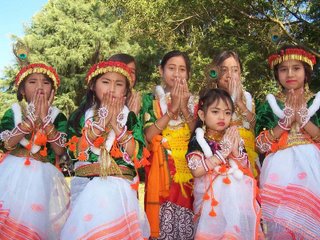 You may have not got over the excitement of the vista, the emerald groves, when a few moments ahead, nestled in the hills, one comes across a majestic placid lake amidst the sylvan heights. The green of the surroundings, the azure blue of the skies have a hypnotising effect. The placid setting is truly idyllic. Water sports and angling are the prime attractions in the Orchid Lake Resort here.
You may have not got over the excitement of the vista, the emerald groves, when a few moments ahead, nestled in the hills, one comes across a majestic placid lake amidst the sylvan heights. The green of the surroundings, the azure blue of the skies have a hypnotising effect. The placid setting is truly idyllic. Water sports and angling are the prime attractions in the Orchid Lake Resort here.The enchanted Shangrilla, 'The Scotland of the East' is not very far ahead and as the car strains itself up the final climb, you are soon in Shillong the town to be there, to get away from the humdrum of city life. Shillong is the town of the famed Wards Lake, Lady Hydari Park, Golf Links, The Shillong peak(1965 mtrs), the Spread Eagle, Crinoline and Bishop, Beadon Falls, the Cathedral of Mary Help of Christians; all spots with a charm of their own.
 Shillong is the base point to go to Mawsynram the wettest spot on the earth, the caves near Mausmai, Nature trekking in the hills is also an exilarating experience where one can embrace the plethora of the three hundred varieties of orchids that abound in Meghalaya like the Blue Vanda, the Lady's Slipper, and that botanical wonder, the carnivorous Pitcher Plant.Shillong an experience you will cherish lifetime.
Shillong is the base point to go to Mawsynram the wettest spot on the earth, the caves near Mausmai, Nature trekking in the hills is also an exilarating experience where one can embrace the plethora of the three hundred varieties of orchids that abound in Meghalaya like the Blue Vanda, the Lady's Slipper, and that botanical wonder, the carnivorous Pitcher Plant.Shillong an experience you will cherish lifetime.Wednesday, August 23, 2006
Sailing to Majuli the world largest river island
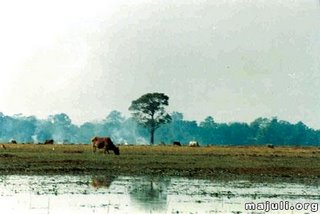 Crested in the bosom of the mighty Brahmaputra and fondly tucked up by Lohit and Khabalu with loving care, the land mass Majuli enjoys the priviledge of being the largest river island in the world. The inscap of its landscape cannot escape from the imagination of anyone travelling through it. Its individual distinctiveness is that it is not uphill, down dale, snow capped mountains or warbling mountain springs which put a tourist into the thrall in Majuli, but it is the freedom of the wind, the freedom of the rivers, the vistas of freedom opening up one after another, the freedom of the birds and the pristine primitiveness, simplicity and innocence of the people living for centuries at close proximity of nature that sways, excites and thrills the imagination of the tourists.
Crested in the bosom of the mighty Brahmaputra and fondly tucked up by Lohit and Khabalu with loving care, the land mass Majuli enjoys the priviledge of being the largest river island in the world. The inscap of its landscape cannot escape from the imagination of anyone travelling through it. Its individual distinctiveness is that it is not uphill, down dale, snow capped mountains or warbling mountain springs which put a tourist into the thrall in Majuli, but it is the freedom of the wind, the freedom of the rivers, the vistas of freedom opening up one after another, the freedom of the birds and the pristine primitiveness, simplicity and innocence of the people living for centuries at close proximity of nature that sways, excites and thrills the imagination of the tourists.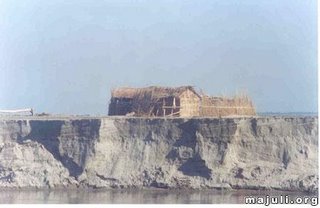
During the monsoon, the rivers swell and vast tracts of land are submerged. The old and the young, and even children steer clear on their rowing boats to safe destinations. No one seems scared of the swelling torrents and no depths seem unchartered water for them. The receding flood water leaves layers of white and greyish silt over the land and in autumn the land is a fire with colour. Land is "ploughed, plotted and pieced" and crops sprout up luxuriantly. The mustard seeds bloom into yellow gold, heave and sway in sprightly dance and ask an onlooker to share their joys. At night wild geese and ducks fly in flocks high above one's head to far-away destinations. Wild birds of a thousand kinds-local as well as migratory swarm the beels and rivers in Majuli.
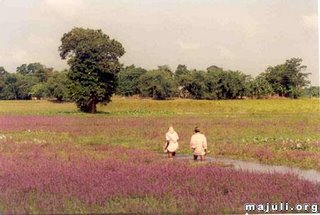
Majuli is known the world over in academic circles for the Xatras which have preserved the Vaisnavite culture. Sankardeva gave classical songs, dances and dramas and a philosophy to the common people over five hundred years ago and a visit to the Xatras, and especially, on festival days like Janmastami or Rasa will inform any tourist that Xatria culture is an inexhaustible source of joy. The dances are colourful and spectacular and they can be unfailing sources of joy as well as subjects for research and investigation.
There are islands within islands in Majuli and like a capricious woman quickly changing her mood, the landmass keeps changing its shape after every summer. Its beauty reminds a visitor of the shifting reality of the rainbow.
Photo Source: www.majuli.org
Saturday, August 19, 2006
Jatinga's Bird Mystery

As fog comes on a moonless night........
when the wind blows in direction right.....
Jatinga turns into an island of search light,
& birds appear like ghosts from nowhere.
Do birds commit suicide? This was the foremost question in the minds of bird enthusiasts and of those idly curious. Birds come in hundreds to Jatinga and die. This much is commonly subscribed to.
Birds are trapped by bird lighting at Jatinga. They are attracted by artificial lights on dark moonless nights and are either killed or trapped. A similar light phenomenon occurs in the Philipines in about the same time and in similar climatic conditions i.e. on foggy,windy and moonless nights. While most of the birds are trapped with what they call "Tawang" in the Philippines are supposed to be migrants, those at Jatinga are not necessarily so.

True, the villagers of Jatinga killed the birds for their table. But they treated it as a sport. The villagers do not betray any sense of guilt. They had countered our shocked disbelief by asking point blank: "Don't you kill fish in the plains in a similar manner with the years first flood? They considered the coming of the birds to be a gift of the Gods.
Jatinga is a Jeme-Naga word meaning pathway of rain and water. In the 1890s some Jeme-Naga people came to survey the area and camped there for a couple of days. Seeing their camp fires attract birds they suspected something mysterious and thought better of permanently settling in the area. Even now, in the Lomromom hill, there is no permanent human settlement. The people of Jatinga and of neighbouring areas consider that place unhealthy and not necessarily for earthly reasons.
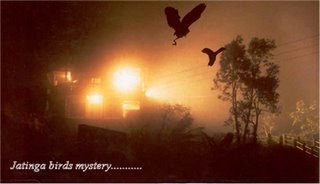
Birds come in large numbers from August to October on foggy moonless nights. Even in July and November birds appear, but in decidedly fewer numbers. The time of the phenomenon occuring coincides with that of migration. This valley falls on the migratory route of locally migrating birds-the Borail being the psychological as well as physiological support along which they could fly. And all the thirty seven species observed and recorded are local migrants. On moolit nights without fog, species like the Pond Heron and the Cattle Egret were seen moving further south in small flocks over coming this ridge. These species were later i.e. after the Phenomenon, observed at Harangajao, a place about 10 K.M. away aerially in the south, which is the ideal habitat for these species.
Wednesday, August 16, 2006
The Land of great one horned Rhino Part II
 In other words, if nature and the Brahmaputra had not designed such a varied habitat, it would have been extremely difficult for man to create a national park so well suited to so great a variety of wildlife like Kaziranga National Park.
In other words, if nature and the Brahmaputra had not designed such a varied habitat, it would have been extremely difficult for man to create a national park so well suited to so great a variety of wildlife like Kaziranga National Park.Visitors can go round the park either on trained elephants, or drive around its roads in vehicles accompanied by guards of the Forest Department. Elephants move slowly and so they do not cover as much ground as a vehicle might. But then the chances of getting close to wildlife are much higher on elephant back than they are in a vehicle. In neither case should visitors wear bright clothes, talk loudly, smoke, make sudden movements and they must not leave their elephant or vehicle while in the Park.
However, the main attraction of Kaziranga, the great Indian one-horned rhinoceros, is very easy to see. Rhinos graze like domestic cattle in the grasslands and marshes around the Park and can be spotted belly deep in the marsh, chomping contentedly on succulent grass.
There are a number of interesting birds in Kaziranga including the weaver bird, whose nests hang like bottles made of straw, and the lesser adjutant stork which breeds in this National Park. Among the shallow-water birds are egarts and pond herons, river terns, black-necked storks and occasionally the open-bill storks, distinguished by the gap between their upper and lower bills even when they are tightly closed. Then there are the beautiful fishing eagles : Pallas's fishing eagle, which tends to avoid the shallower bheels and the infrequently-spotted grey-headed fishing eagle. Early in the year the visitor might see patridges and bar-headed geese. As for the ever popular grey pelican, these fishing birds with their shopping-bag beaks nest on tall trees near the village. They are also a fairly common sight swimming like short-necked swans in the bheels both in and around the National Park.
But even if the visitor does not see a single interesting bird, or a rhinoceros a most unlikely event even at the worst of times the trip will not be in vain. There is a magic about being in the wilderness that cannot be matched by any other encounter.
The Land of great one horned Rhino

 Kaziranga National Park is the only National Park in India situated in central Assam with an area of 430 Sq.kms. It is the home of the great Indian one horned Rhinoceros(Unicornis).The landscape of Kaziranga is of sheer forest,tall elephant grass,rugged reeds,mellow marshes and shallow pools.So far the history of Kaziranga is concerned Lady Curzon first heard about Rhino of Kaziranga from her British tea planter friends and came to Assam in 1904-05. Although she could not see the animal she spotted hoof prints with three toes. Which convinced Lady Curzon that such an animal did exist. On her return she persuaded Lord Curzon to do something to save this animal from total annihilation. Lord Curzon set the wheels of British bureaucracy rolling and on 1st June,1905, a preliminary notification announcing the intention of the Government to declare 57,273.60 acres of Kaziranga as a reserved forest was issued. Finally, Kaziranga was declared as reserved forest on 3rd January,1908 and was officially closed for shooting.
Kaziranga National Park is the only National Park in India situated in central Assam with an area of 430 Sq.kms. It is the home of the great Indian one horned Rhinoceros(Unicornis).The landscape of Kaziranga is of sheer forest,tall elephant grass,rugged reeds,mellow marshes and shallow pools.So far the history of Kaziranga is concerned Lady Curzon first heard about Rhino of Kaziranga from her British tea planter friends and came to Assam in 1904-05. Although she could not see the animal she spotted hoof prints with three toes. Which convinced Lady Curzon that such an animal did exist. On her return she persuaded Lord Curzon to do something to save this animal from total annihilation. Lord Curzon set the wheels of British bureaucracy rolling and on 1st June,1905, a preliminary notification announcing the intention of the Government to declare 57,273.60 acres of Kaziranga as a reserved forest was issued. Finally, Kaziranga was declared as reserved forest on 3rd January,1908 and was officially closed for shooting.On 28th January,1913 the area of reserved forest was expanded with the inclusion of another 13,506 acres Kaziranga was declared a "Game Sanctuary" on 10th November,1916. In 1938 the then conservator of forest, A.J.W. Milroy stopped all poaching and opened Kaziranga to visitors. Because the word 'game' connotated animals for hunting, in 1950, the then senior conservator of forest Mr.P.D.Stracey, changed the term to 'wildlife sanctuary'. Gradually the sanctuary begun as a nucleus encompassing a small area,expanded to its present size. Finally on 11th February,1974, the designation was changed to "Kaziranga National Park". Kaziranga now covers an area of 430 sq.km. Few sanctuaries anywhere can provide as certain an assurance of a unique setting and sight of its best known wild animals and birds as can Kaziranga.
The Park lies on the flood plain of the mighty Brahmaputra river sloping, very gradually, from east to west. The Karbi Anglong Hill ranges rise around the Park pressing it against the great flood of the Brahmaputra flowing as its northern boundary. Into the soup plate between the river and the ranges flow the rivulets Mora Diffoloo, Diffoloo, Bhengra, Borjuri, Diring, Kohora, Dehing, Bhalukjuri and Deopani. They bring down rich silt and sand, spread in small lakes known as 'bheels', silt up the lakes to make swamps and marshes, alluvial grasslands rising to alluvial savannah woodlands; and then, as the climate losses its humidity with height, rise to mixed deciduous forests and, finally, to tropical evergreen forests.
Monday, August 14, 2006
India

India,it is often said,is not a country but a continent.From north to south and east to west,the people are different,the languages are different,the customs are different,the country is different.There are few countries on earth with the enormous variety that India has to offer.It's a place that somehow gets into your blood.Love it or hate it you can never ignore India.India is a triangle with the top formed by the mighty Himalayan mountain chain.Here you will find the intriguing Tibetan region of Ladakh and the astonishingly beautiful Himalayan areas of Kashmir,Himachal Pradesh,the Garhwal of UttarPradesh and the Darjeeling and Sikkim regions.South of this is the flat Ganges basin with the colourful and comparatively affluent Punjab to the north-west,the capital city New Delhi and important tourist attractions like Agra(with the Taj Mahal),Khajuraho,Varanasi and the holy Ganges.This plain reaches the sea at the northern end of the Bay of Bengal where you find teeming Calcutta(now Kolkata),South of this northern plain the Deccan plateau rises.
Basically india is what you make of it and what you want it to be.If you want to see temples there are temples,if it's history you want India has plenty of it;the forts,abandoned cities,ruins,battlefields and monuments all have their tales to tell.If you simply want to lie on the beach there are enough of those to satisfy the most avid sun worshipper.If walking and the open air is your thing then head for the trekking routes of the Himalaya,some of which are as wild and deserted as you could ask for.If you simply want to meet the real India you'll come face to face with it all the time.India is not a place you simply and clinically 'see';it's a total experience,an assault on the senses,a place you'll never forget.
Source:Lonely Planet